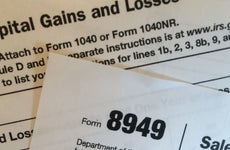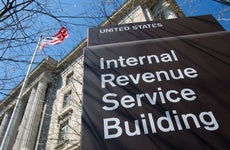When do we owe tax on RMDs? Can income tax withholding occur with last distribution?

The Bankrate promise
At Bankrate we strive to help you make smarter financial decisions. While we adhere to strict , this post may contain references to products from our partners. Here's an explanation for .
Dear Tax Talk,
My husband Rich turned 70 1/2 in February of 2016. We decided to postpone taking out his total required minimum distributions, or RMDs, and took only a portion so we could create a taxable event in 2016 to take advantage of the deductions and exemptions. So now he will be required to take the remaining 2016 RMD prior to April 1, 2017 and the 2017 RMD prior to Dec. 31, 2017. So, we will be paying taxes on two RMDs when we file in 2018.
My question: When is he required by the IRS to pay taxes on the first RMD — at the time the first RMD is withdrawn, or can he wait and have the total tax liability taken out of the second RMD in December? Or do we have to pay estimated taxes? I have gotten two different answers, but I believe there should be a definitive answer — one that can be backed up by IRS documentation. We live in South Dakota, which has no personal income tax, so there would be no issues in that area.
Any information you can provide would be most welcome.
Thank you,
— Bonnie
Chris Ryan/Getty Images
Dear Bonnie,
As long as you are having the taxes withheld from an RMD, then the choice is yours to make. This means you can have them all withheld on the second distribution if that is what you want.
IRS Publication 505, Tax withholding and Estimated Tax, provides the answer you are seeking, but you have to look closely to see it. If your income tax withheld is sufficient to avoid penalties, then you do not need to make estimated tax payments. You just need to be extra sure that the amount of income tax withheld is enough to make you penalty proof.
Underpayment penalty general rule:
For 2017, you may owe an underpayment of tax penalty if you owe $1,000 or more with your tax return and the total income tax withheld does not equal at least the smaller of:
- 90 percent of your 2017 tax, or
- 100 percent of your 2016 tax (must cover a 12-month period).
There is one caveat and that is if your adjusted gross income for 2016 is more than $150,000 ($75,000 if your filing status is “married filing a separate return”). If that’s the case, then use 110 percent in No. 2 above.
There are different rules for farmers and fishermen, but that is beyond the scope of our discussion.
Uncle Sam operates as a “pay as you go” system, which means that if you do not have enough income tax withheld, then you need to make quarterly estimated tax payments using Form 1040-ES Estimated Tax Payments for Individuals.
All the information you need is in IRS Publication 505.
Thanks for the great question and all the best to you and your husband.
RATE SEARCH: Shopping for a mortgage? Compare mortgage rates today at Bankrate.com!
Ask the adviser
To ask a question on Tax Talk, go to the “Ask the Experts” page and select “Taxes” as the topic. Read more Tax Talk columns.
To ensure compliance with requirements imposed by the IRS, we inform you that any U.S. federal tax advice contained in this communication (including any attachments) is not intended or written to be used, and cannot be used, for the purpose of (i) avoiding penalties under the Internal Revenue Code or (ii) promoting, marketing or recommending to another party any transaction or matter addressed herein. Taxpayers should seek professional advice based on their particular circumstances.
Bankrate’s content, including the guidance of its advice-and-expert columns and this website, is intended only to assist you with financial decisions. The content is broad in scope and does not consider your personal financial situation. Bankrate recommends that you seek the advice of advisers who are fully aware of your individual circumstances before making any final decisions or implementing any financial strategy. Please remember that your use of this website is governed by Bankrate’s Terms of Use.
Related Articles


Need to report cryptocurrency on your taxes? Here’s how to use Form 8949 to do it

Cryptocurrency taxes: A guide to tax rules for Bitcoin, Ethereum and more
